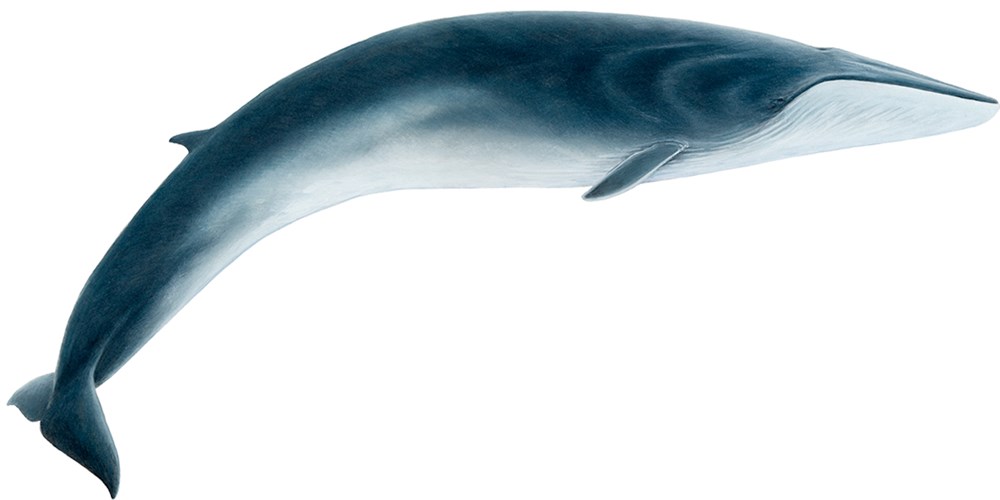Fin whale
(Balaenoptera physalus)

Description
The fin whale ( Balaenoptera physalus ),also called fin whale,is a species of cetacean,mycetite,of the Balaenopteridae family.In size,this animal is the second largest existing on the planet,second only to the blue whale.It can reach a length of 27 meters.2Its body is long and stylized,of a grayish brown color,less in its lower part,which is whitish.There are two distinct subspecies: the northern rorqual,which has its habitat in the North Atlantic,and the larger Antarctic rorqual,which habitually lives in the waters of the Antarctic Ocean.It can be seen in the main oceans of the planet,from polar to tropical waters.The species is absent only from waters near the ice blocks of both poles and from certain areas,relatively small,far from the open sea.Its highest population density is found in cold and temperate waters.3 It feeds mainly on small fishwhich are grouped in schools,squids,crustaceans such as the Misidáceos and krill.Like all other mysticettes,the fin whale suffered intensive hunting during the 20th century and is classified as an endangered species.Almost 750,000 of these fin whales were hunted in the southern hemisphere only between 1904 and 1979,4 and currently there are only less than 3,000 in that region.5 The International Whaling Commission (IWC) has established a moratorium on the commercial whaling of this whale,6 although some countries such as Iceland,Norway and JapanThey continue their hunt at certain times of the year.7 For the 2008 season,Japan indicated its intention to kill approximately 1000 whales (about 850 minke whales,50 fin whales and 50 whales ),even foreseeing that its goal would not be reached if financial cuts were caused by environmental protests.8 The species is also hunted by Greenlandic aborigines authorized by the Aboriginal Subsistence Hunting program led by the IWC.9 Under this program 377 whales were hunted in 2007,of which 12 were fin whales.10Collisions with ships and noise from human activity in the oceans pose a major threat to the recovery of the speciesThe common fin is characterized by its large size and its slender body.The average size of males and females of the species is 19 and 20 meters,respectively.The rorquals of the subspecies of the northern hemisphere reach a smaller size than the Antarctic subspecies and the females are larger than the males: the largest female captured in Antarctica measured 27.3 m compared to 24.4 m in the Arctic,and the largest Antarctic male reached 24.4 m and in the Arctic 23.8 m.18 There are still no records of the weighing of an adult specimen,but it is estimated that a 25-meter adult weighs around 70 tons.They reach full physical maturity between 25 and 30 years,and live an average of 75 years,although there are records that indicate that these whales can live around 100 years.19 20 A newborn is approximately 6.5 m long and weighs about 1800 kg.20 Its large size helps the identification of the animal,although it is sometimes confused with the blue whale,with the northern whale and,in warm waters,with Bryde's whale. The upper part and the sides are brownish gray and the lower part is whitish.It has a pointed snout,double spiracles and a broad and flat nose.Two light-colored inverted V-shaped marks begin behind the spiracles and continue down the sides towards the tail on a diagonal that slopes towards the top until reaching the dorsal fin,sometimes curving forward in the back.2 It has a white mark to the right of the lower jaw and on the beards on the same side,while the left side is ashen or black.21 Despite being able to occasionally see themselves in the minke whale,this asymmetryIt is universal in the rorcual common and unique among cetaceans,being one of the key characteristics to identify this species.A hypothesis to explain the development of this asymmetry considers that it is induced by the preference of the whale to swim on its right side when it rises to the surface to jump back into the water and to move to the right when it is on the surface above the surface.a dam.Other whales,in the same circumstances,usually move to the left.Despite the existence of several hypotheses that attempt to explain this asymmetry,none has been accepted in scientific circles.The rorqual has a series of 50 to 60 and up to 86 (with an average of 64) gular folds along the lower part of the body,which run from the tip of the chin to the navel,23 which allows the area of the throat to expand greatly during feeding.It has a curved and prominent dorsal fin (60-70 cm) that is approximately in the last third of the body.23 The fins are small and sharp and the tail is wide,pointed and with a notch in the center.When it reaches the surface,the dorsal fin becomes visible immediately after expelling through its spiracles a vertical and narrow jet of water that can reach six meters in height or even more.24 While feeding,they snort in rapid succession 5-7 times,but when they travel or rest they only do it once every minute or two.When performing the last dive,they raise and arch the back showing their characteristic dorsal fin,but they do not usually draw the tail out of the water.Then they dive to depths of 250 meters or more to feed,or just a few meters while traveling or resting.Dives in the area of California and Baja Californiathey last about six minutes,with a maximum of 17 minutes;Traveling or resting,they just dive for a few minutes at a time.25 20 Although they can manage to do it,rarely taking the leap completely out of the water.
Taxonomic tree:







